Digital Frontier
Header
Main
CG MAKING
I AM A HERO
April 2016 [VFX]
Character Transformation and Subtle Eye Movements
What shot best demonstrated the power of the compositing team?
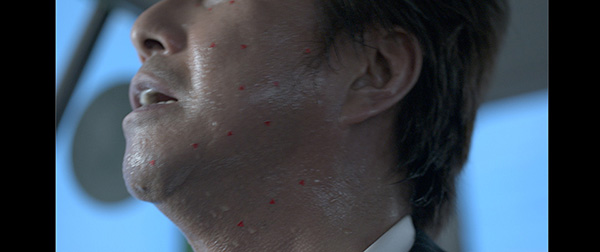 Live action plate with markers attached.
Live action plate with markers attached.
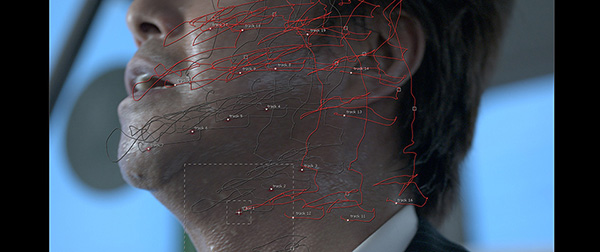 Using Nuke to track markers, sweat and skin detail.
Using Nuke to track markers, sweat and skin detail.
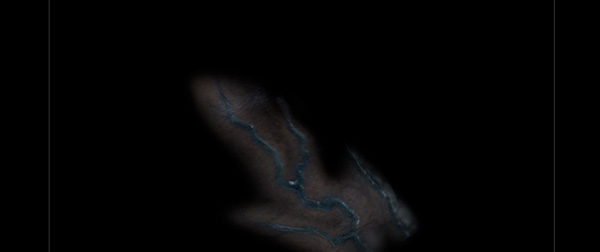 Blood vessel texture when the character changes into a ZQN
Blood vessel texture when the character changes into a ZQN
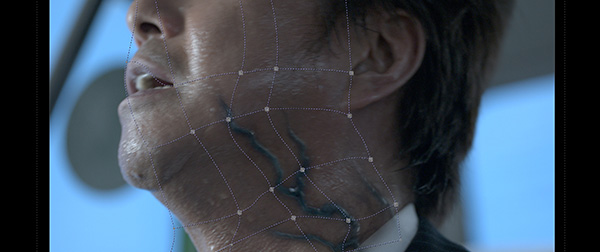 Matching the live action plate using Gridwarp.
Matching the live action plate using Gridwarp.
It was impossible to track every marker in the shot. At the end of the day, we made the decision to do some of the effect work by hand using the markers as a reference. The amount of work needed was really intense but we all got fired up after seeing the first offline footage. We all thought “wow, this looks like it’s going to be a really good film”. And the CG team realized that we had never gotten a request to do a film of this high caliber before. We obviously had time constraints as well so every day was a battle to decide what the most important thing to focus on.
Creating “High Jump”, the highest level ZQN, in CG
Within the A-Rank ZQNs there is a character of the ultimate rank called “High Jump”. Unlike other ZQNs, his character required various types prosthetics and VFX depending on the scene. To have a zombie that transformed from scene to scene probably almost never occurs in other zombie films.
When we worked on the destroyed model, a Japanese prosthetics team made us a detailed model which we then 3D scanned. It was useful for us to receive a model from the prosthetics team for two reasons. One, we were able to work on a CG ZQN model that was the exact same design as the non-CG model. Two, by scanning a near complete model and being able to look at the actual model while working, we were able to do accomplish two things: shorten CG production time, and spend more time refining details in the model. Including High Jump’s final scene, we were able to destroy ZQNs using pieces created by the character team and created the explosion of small detailed pieces not through boolean operation but part by part by hand. So we were able to scatter even small pieces like the eye and tongue. These models were then used as a base by the effects team to create secondary destruction. A broken piece hit by a bat would then once more break. From here, blood would then ooze out.
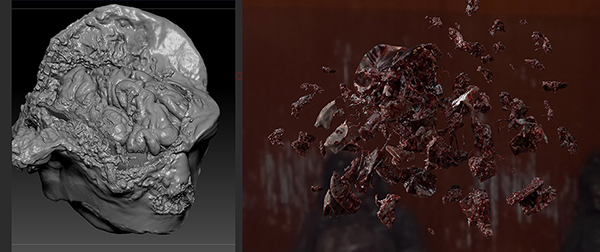 Detailed model of a head after being destroyed.
Detailed model of a head after being destroyed.
The character team’s job was to increase the amount of times that High Jump shed blood around him. There were many times where corpses would fall and at those moments we would add blood.
Regarding the amount of blood seen, we thought through trial and error whether to go for a realistic amount vs a stylistic showy look. There were shots where we definitely pushed what was a realistic amount of blood.
We’d try to render it once, then realize there wasn’t enough blood and then we’d add more. Sometimes adding blood was just for aesthetic purposes too.
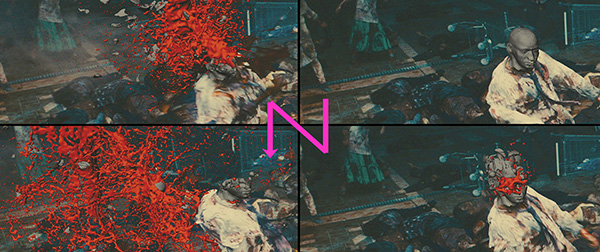 Simulation of the destruction of a ZQN head
Simulation of the destruction of a ZQN head
Creating the Eye
The ZQN eye is completely CG. At the beginning we considered using contacts on the eyes but applying them to a ton of actors for every scene proved to be expensive so we decided to try out doing the eyes using VFX. Regarding contacts of course there was some concern about safety but the actors themselves also just seemed to hate the idea. In traditional zombie films, eyes shine, get bloodshot and then turn white during zombie transformation scenes. In this film after talking with the Director we decided to create the “white eye” look by congesting the eyeball with blood, then adding a sense of cloudiness to the iris. When the iris is still black the victim is still human but the moment that he turns fully into a ZQN is when the pupil itself gets cloudy. Here we congested the pupil via CG. We created the eye by downloading 3D eye model into Nuke and then adding a texture to it.
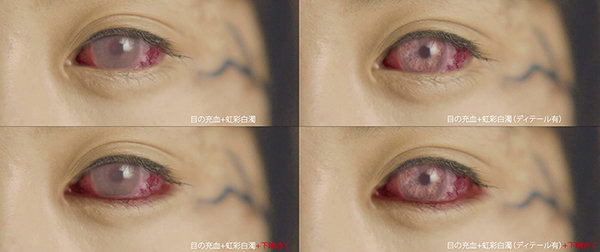 ZQN Eye Test
ZQN Eye Test
To reflect scenery onto the eyeball, we shot HDRI (HDR) footage on set and projected onto the eye.
*HDRI(High Dynamic Range Images)
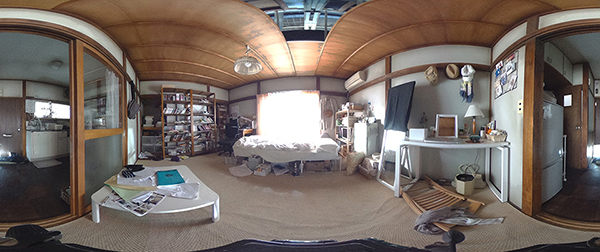 HDRI of Hideo’s Room
HDRI of Hideo’s Room
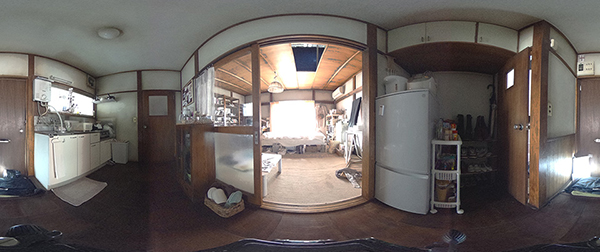 HDRI of Hideo’s Room Entry hall
HDRI of Hideo’s Room Entry hall
One interesting part about making the eye was moving the eyeball. We made it as a 3D model so it was easy for us to move it wherever we wanted. So we could make small adjustments to eye performances. For instance, when a human turns into a ZQN they go cross-eyed, we wanted subtle eye movements. So we shot the left/right eye movement of each eye separately on set. We then composited both eye movements and processed them in post so that one eye followed the other. Both the eyes and the muscles around the eyelid move and twitch. We wanted real eyelid movement so we actually shot the actor performing this movement and then used it in the composite.
This time there was a considerable amount of work where we had to adjust the color of the on-set footage to blend with the HDR footage. For all of these, we took color charts and performed color matching on rendered physics-based CG footage after it had been composited. This was a necessary part of the process for this project. In the past, there was a few times where we matched color purely with our eye. With the work we did for the eye and the process of using Nuke to download the model data, we learned a lot on this project.
ANDO
It was great working on shots where a character’s face transforms into a ZQN. In the moment where the transformation occurs, blood vessels start to rise to the surface and break out all over the victim. We used CG to create this moment but to get it to look right an extremely difficult type of tracking was required. We took one frame, cut a mask out of it and then used it to spread the effect. But as the effect spread to shadowy areas in the original footage, it was insanely difficult to make the effect match the same shadowy feel of the original footage. We placed markers where necessary on the actor but using these markers to figure actual measurements on across the skin surface became arduous. The skin often expanded and contracted so even with the marker points, slippage was unavoidable. We used Nuke’s Mesh Up and Gridwarp points to constrain the points and as we controlled their relationship to each other via “expressions” we constructed the transformation such that it actually looked like it was flush to the skin’s surface.
It probably would have worked better if we attached more markers to the surface of the skin for this effect. But during shots, we often saw sweat cover markers in the middle of a take so if it’s difficult to judge whether or not increasing the amount of markers would have helped. As expected, editing these blood vessels parts took the most work and we eventually would have to delete the markers from the shot. Sure putting more markers in could have helped us, but we’d also have to spend more time deleting each one too. Luckily we didn’t have too many to erase (laugh). All we could do was feel things out.